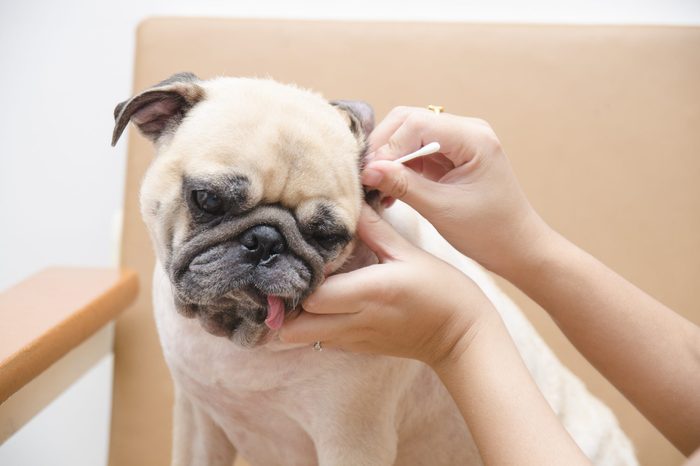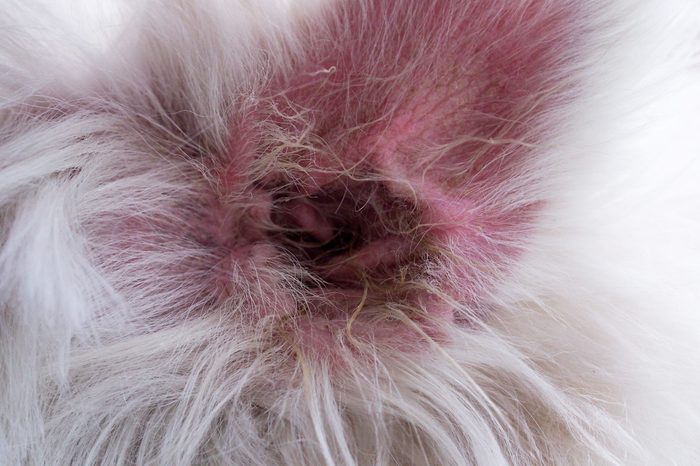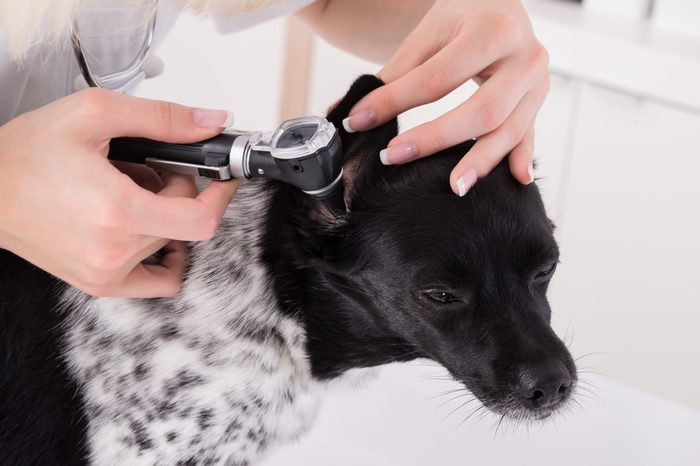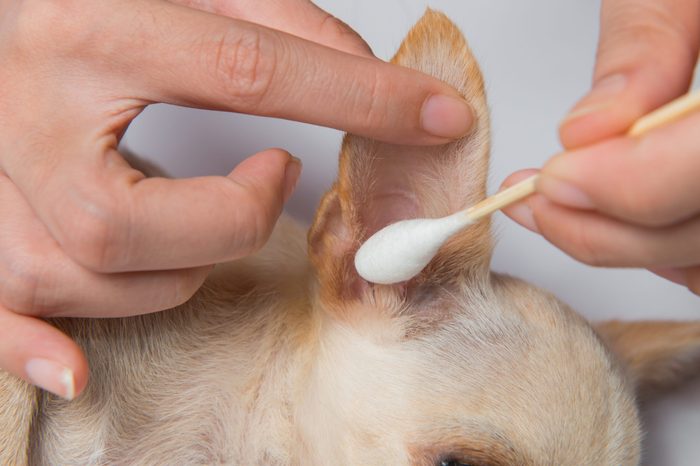
What you need to know about dog ear infections
A dog ear infection can happen in one or both ears, and they can turn up occur in different parts of the ear—and that will change the kinds of symptoms your dog has. Inflammation in the external part of the ear canal—otitis externa—is the easiest to treat, according to VetOrganics. But if you don’t address the problem, the infection can spread to other parts of the ear and become more serious.
You won’t be shocked to learn that otitis media is an infection of the middle ear, and otitis interna is in the inner ear (it can also be called labyrinthitis). Vets are more concerned about inner ear infections because that’s where nerves for hearing and balance are located.

What types of dogs get ear infections the most?
If your dog has long, floppy ears they may be more prone to ear infections—their ears are more likely to trap dirt and moisture, forming a breeding ground for bacteria. Cleaning can help your dog’s ears avoid getting an ear infection—here’s how often you should be cleaning your dog’s ears.
Dogs that have allergies and those that spend time in the water are also more likely to get ear infections. Any dog, however, can get an ear infection. According to Hanie Elfenbein, DVM, the dog breeds most prone to ear infections include:
- Pit bulls
- Poodles
- Cocker Spaniels
- Shar-Pei

What causes ear infections in dogs?
According to Caroline Wilde, DVM, a staff veterinarian for Trupanion, yeast and bacteria are both common causes of dog ear infections. Infections have many causes, including parasites, viruses, wax buildup, foreign objects stuck in the ear, and hairs that grow deep within the ear canal. Medical conditions such as thyroid disorders can also cause ear infections to develop. Keep these 28 safety tips in mind when you take your dog outside to play.
Another common cause is allergies, including food allergies. “The typical allergy-inducing culprits in dog ear infections are grain and chicken,” says Jme Thomas, Executive Director at Motley Zoo Animal Rescue. Thomas recommends choosing foods made from lamb, rice, duck, and potatoes if you suspect that food allergies are causing the problem. “New food won’t cure an already existing infection, but it can help make your dog less prone in the future,” she says. Thomas recommends trying any dietary change for at least three to six weeks, and continuing with the medication your dog’s vet has prescribed.

Sign: Your dog shakes his head—a lot
If your dog is vehemently shaking his head from side to side, he’s not trying to say no. He may, however, be trying to tell you that he has an ear infection. “Ear infections itch. One of the ways your dog tries to show you this is by shaking their head,” explains Dr. Wilde. Shaking his head is your dog’s way of scratching that itch. This symptom can also be a sign of other ear conditions in dogs, such as ear hematomas or ear vasculitis. If your dog is shaking his head, either with or without other symptoms, a trip to the vet is a good idea. Don’t confuse head shaking with head tilting. This is the scientific reason why dogs tilt their heads.

Sign: Scratching her ears
Given how itchy a dog ear infection can be, it won’t come as a surprise that scratching is another common symptom. In an effort to get at the source of the itch, your dog may scratch at their ears, head, and other parts of their body. This can lead to another symptom—open sores caused by too-long or too-sharp doggy nails. “The itching from ear infections may be intense enough to lead to wounds in and around the ears,” explains Jennifer Coates, DVM, who serves on the advisory board of Pet Life Today.

Sign: Sliding his head on the rug
That uncontrollable itch might also cause your dog to do some odd gymnastic-type moves, particularly if you have carpet or rough-textured area rugs. “When dogs or cats have ear infections, they often slide their heads across the carpet and/or paw at their ears to relieve the discomfort. In some instances, the eyes may get in the way. Many pets who slide and roll around on carpeting end up with eye issues—red, raw, irritated, swollen eyes—as a result,” says integrative veterinarian, Carol Osborne, DVM, of Chagrin Falls Veterinary Center & Pet Clinic.

Sign: Smelly ears
Fungal infections, bacterial infections, dead skin cell buildup, and ear wax buildup can all cause a foul odor to come from your dog’s ears. You may not notice the smell if your dog has long, floppy ears unless you lift them up and take a whiff. Sometimes the smell caused by an ear infection will have a yeasty, damp earth, or vinegary tang. According to Pet MD, ear odor in and of itself, however, does not always indicate the presence of an ear infection.

Sign: Icky ear discharge
Fluid may leak from your dog’s ears if they have an ear infection. Other times, the discharge may not be apparent unless you gently go into the ear canal and wipe some of it out (a job best left to a veterinarian, to avoid damaging the ear canal). “With yeast infections, the discharge tends to be brownish/blackish. With bacterial infections, the discharge can range from yellow to dark,” explains Dr. Wilde. “If you look down into the ear, it may seem filled with dark or multicolored, waxy debris,” explains Sara Ochoa, DVM, a veterinary consultant for DogLab who is also a practicing veterinarian in Texas. No matter what causes it, the discharge associated with a dog ear infection will be the source of any odor, as well. Dogs may not like to smell each other’s ears, but they do like to sniff at each other’s butts—here’s why.

Sign: Inflammation and swelling
If your dog has an ear infection anywhere in the ear, the entire inside of the ear may look bright red, angry, and inflamed. It may also appear swollen. If your dog’s ears seem inflamed and uncomfortable, get her to the vet as soon as possible.

Sign: She’s clearly in pain
A dog ear infection can hurt as well as itch. If the problem spot is the inner ear or middle ear, your dog may feel pain throughout the entire ear or head. You may not realize your dog is in pain until you go to scratch his ears or cuddle, only to hear a yelp—or worse, get a nip—from your loyal friend. It may hurt your heart even more than your hand but it happens. Even the tamest dog may snap at their beloved owner if they are in pain, and the area hurting them is suddenly touched, or accidentally poked. Don’t take it personally, but do take your dog to the vet, pronto.

A serious condition to look out for
If left untreated, ear infections in dogs can escalate, becoming very painful and severe—that’s why you should always make a vet appointment at any sign of a dog ear infection. “Dogs have a very different ear canal than humans and it makes them highly prone to ear infections—to the point that ear issues are in the top five health conditions seen by U.S. veterinarians,” explains Danielle Bernal, DVM, a veterinarian with Wellness Natural Pet Food. “Since the causes vary, so may the clinical signs vary from dog to dog. When left untreated, ear infections can intensify. If left unchecked, a large blood blister called an aural hematoma may form in the ear, caused by the head shaking and scratching your dog is doing to alleviate their discomfort. “Aural hematomas are very painful, and need immediate draining by a veterinarian.”

Symptoms of a severe dog ear infection
Untreated ear infections can cause extreme discomfort for your dog. According to WebMD, symptoms you need to address immediately include nausea, walking in circles, reluctance to open the mouth, and trouble or problems with balance and standing.

Shutting it down before it starts
Keeping your dog’s ears clean is the best way to avoid him getting an ear infection in the first place. Your vet may recommend an ear wash for you to use. Also, make sure to examine your dog’s ears at least once a week for any signs or symptoms of infection. This is particularly important if your dog has long, floppy ears. And make sure to keep your dog’s ears dry at all times. Use a thin cloth draped over your finger to dry their ears after bathing or water sports. Never, ever use a cotton swab—you could hurt your pup’s eardrum. Here are 10 more signs that your dog isn’t feeling well.
